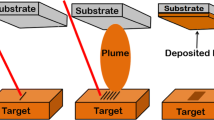Abstract
Ultrashort laser pulses impinging onto solid, strongly absorbing surface deposit their energy within an absorption depth from the surface. This localized energy deposition may result in rapid and very efficient heating of the surface to temperatures far exceeding the melting or boiling point. Temperature evolution at the surface of samples and their electronic structure may be studied with nonperturbing, time-resolved optical diagnostic techniques. Picosecond laser pulses provide the fastest means for heating matter at high temperature, since the characteristic energy transfer times from photoexcited electrons to the lattice occur in this time scale. Surface evaporation is not affecting the observations in this time scale, simply because there is no time for the surface atoms to escape. As an illustration, measurements on graphite are presented here. The complex index of refraction of highly oriented pyrolytic graphite (HOPG) during picosecond laser irradiation has been measured at 1.06 μm via time-resolved ellipsometry at angles of incidence up to 80∘. In particular, a value of the complex index of refraction for the liquid phase has been derived.
Similar content being viewed by others
References
N. Bloembergen,Mat. Res. Soc. Symp. Proc. 51:3 (1986).
J. Fujimoto, Private communication.
J. M. Liu, R. Yen, H. Kurz, and N. Bloembergen,Mat. Res. Soc. Symp. Proc. 4:23 (1982).
G. E. Gellison, Jr., and D. H. Lowndes,Appl. Phys. Lett. 48:721 (1986).
P. M. Fauchet and W. L. Nigham, Jr.,Appl. Phys. Lett. 48:785 (1986).
A. G. Whittaker, P. L. Kitner, L. S. Nelson, and N. Richardson,Aerospace Corp. Rep. No. SD-TR-81-60 (unpublished).
T. Venkatesan, D. C. Jacobson, J. M. Gibson, E. S. Elman, G. Braunstein, M. S. Dresselhaus, and G. Dresselhaus,Phys. Rev. Lett. 53:360 (1984).
J. Steinbeck, G. Braunstein, J. Speck, M. S. Dresselhaus, C. Y. Huang, A. M. Malvezzi, and N. Bloembergen,Mat. Res. Soc. Symp. Proc. 74:263 (1987).
C. Y. Huang, A. M. Malvezzi, N. Bloembergen, and J. M. Liu,Mat. Res. Soc. Proc. 51:245 (1986).
A. M. Malvezzi, N. Bloembergen, and C. Y. Huang,Phys. Rev. Lett. 57:146 (1986).
J. Heremans, C. H. Olk, G. L. Eesley, J. Steinbeck, and G. Dresselhaus,Phys. Rev. Lett. 60:452 (1988).
E. A. Taft and H. R. Philipp,Phys. Rev. 138:A197 (1965).
Author information
Authors and Affiliations
Rights and permissions
About this article
Cite this article
Malvezzi, A.M. Picosecond laser heating and melting of graphite. Int J Thermophys 11, 797–809 (1990). https://doi.org/10.1007/BF01184346
Issue Date:
DOI: https://doi.org/10.1007/BF01184346




